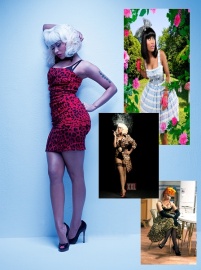Sent to you by moya via Google Reader:
 As BET gets set to air its documentary about women and hip hop Monday, I am finding my 30-plus, old school feminist-self working hard to gear up to get down with the over-the-top, lyrically layered, brand savvy rapper that is Nicki Minaj.
As BET gets set to air its documentary about women and hip hop Monday, I am finding my 30-plus, old school feminist-self working hard to gear up to get down with the over-the-top, lyrically layered, brand savvy rapper that is Nicki Minaj.
The self-described Barbie is inescapable. She works every rap and R&B hook, and changes her looks to fashion what could be categorized as camp, cultural appropriation or classic sexual objectification. Until Minaj, I've managed to safely maneuver around mainstream new millennium starlets because they offered no more than a cookie-cutter replica of the unique hip hop dynamism I remembered. (See the links to artists below.) Likened to Lady Gaga for her eye-catching performances, this former theater student is adept at staging media spectacles, such as autographing breasts, adopting different voices, and orchestrating a coming-out tweet to squash rumors about her bisexuality for those who might have misread the Remy Ma viral video confession from her masculine persona, Roman, as Nicki Minaj. You can call the latter a cop-out or a capitulation to a commercial model that demands that all women perform hyperfemininity period. As I enter Nicki's world (slowly and with caution), I am not only considering the ways she uses her body, but I am thinking of three ways her performances of race, gender and sexuality instigate a feminist engagement with the popular.
 1. Beauty and Postfeminism
1. Beauty and Postfeminism
Postfeminism advertises the sexy, smart, economically successful self-absorbed it-girl from a post-patriarchal world where politics are defined by "style wars" rather than issues of gender inequity. Here, beauty and postfeminism seem to be disconnected from critiques of consumerism, gendered labor, or political citizenship. On the one hand, the look-good-feel-fine empowerment that Minaj offers feels as lifeless as the dolls she suggests every girl wants to be—you know, the nonspeaking, decorative, plastic bodies to be handled and watched. Then again, I can imagine her Barbie thang as her way of injecting a sense of beauty and wonderment for homegirls, like herself, who've had to create other worlds to escape the ugly one they lived every day. In either case, Minaj has managed to capture the attention of young women—hook, line and stiletto.
 2. The Lady and The Freak
2. The Lady and The Freak
In what could be described as a post-Tip Drill moment where folks are "manning" the line to distinguish the ladies from the freaks, Nicki Minaj is not the only one who is creating personas to perform otherness. As Roman Zolanski she can express desire for another woman, and as Harajuku Barbie she can perform a sexualized Asian girlhood without damaging the central "brand" or image. Beyoncé is another celebrity with a freak persona. In big hair and tall heels, Sasha Fierce does Beyoncé's "dirty work." Both entertainers talk about a sense of freedom—which is almost always connected to sexual freedom. Celebrity aside, ordinary young women on and off screen are crafting "real" and alternate/virtual identities as a response to the increased policing of their bodies through this hip hop binary. Rather than marking public/private bodies, young women like Minaj are now describing their "real" good bodies and their fake freakish ones. In our sincere efforts to "free the girls," it is possible we might have caged our "real" sexual selves.
 3. Camp, Celebration or Cultural Appropriation
3. Camp, Celebration or Cultural Appropriation
From her Anime-inspired Vibe magazine cover, her Harajuku Barbie persona, to her recent music video, Your Love, where she plays a geisha girl (among others), Minaj reprises dated stereotypes about Asian women that suggest desirability comes in part from submissiveness or obedience. Costuming conceals and reveals her body, and both frame her as the exotic; the hand gestures she does in separate scenes either to seduce her lover or to fight her foe are grafted from other forms of popular culture depicting Asianness. I can remember the debut of the Harajuku Girls shadowing Gwen Stefani at a music awards show. Then, folks flipped about a white woman co-opting Asian culture and parading other women (as objects of her imagination). Yet, as Minaj mines the visual landscape to reinvent herself, her Afroasian encounters – whether camp, celebration, or cultural appropriation – remain unchallenged.
Things you can do from here:
- Subscribe to The Crunk Feminist Collective using Google Reader
- Get started using Google Reader to easily keep up with all your favorite sites
.jpg)
No comments:
Post a Comment